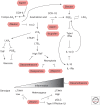Host-Directed Therapies for Tuberculosis
- PMID: 25986592
- PMCID: PMC4588138
- DOI: 10.1101/cshperspect.a021196
Host-Directed Therapies for Tuberculosis
Abstract
Host-directed therapies are a relatively new and promising approach to treatment of tuberculosis. Modulation of specific host immune pathways, including those that impact inflammation and immunopathology, can limit mycobacterial infection and pathology, both in cell culture and in animal models. This review explores a range of host pathways and drugs, some already approved for clinical use that have the potential to provide new adjunctive therapies for tuberculosis. Drugs targeting host processes may largely avoid the development of bacterial antibiotic resistance, a major public health concern for tuberculosis. However, these drugs may also have generally increased risk for side effects on the host. Understanding the specific mechanisms by which these drugs act and the relationship of these mechanisms to Mycobacterium tuberculosis pathogenesis will be critical in selecting appropriate host-directed therapy. Overall, these host-directed compounds provide a novel strategy for antituberculosis therapy.
Copyright © 2015 Cold Spring Harbor Laboratory Press; all rights reserved.
Figures

References
-
- Agarwal N, Lamichhane G, Gupta R, Nolan S, Bishai WR. 2009. Cyclic AMP intoxication of macrophages by a Mycobacterium tuberculosis adenylate cyclase. Nature 460: 98–102. - PubMed
-
- Almeida PE, Silva AR, Maya-Monteiro CM, Torocsik D, D’Avila H, Dezso B, Magalhaes KG, Castro-Faria-Neto HC, Nagy L, Bozza PT. 2009. Mycobacterium bovis bacillus Calmette-Guerin infection induces TLR2-dependent peroxisome proliferator-activated receptor γ expression and activation: Functions in inflammation, lipid metabolism, and pathogenesis. J Immunol 183: 1337–1345. - PubMed
-
- Arbiser JL, Moschella SL. 1995. Clofazimine: A review of its medical uses and mechanisms of action. J Am Acad Dermat 32: 241–247. - PubMed
Publication types
MeSH terms
Substances
Grants and funding
LinkOut - more resources
Full Text Sources
Other Literature Sources
Medical
